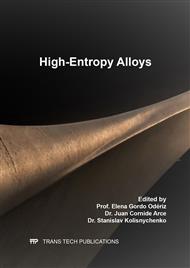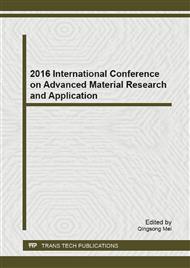[1]
J. Yeh, S. Chen et al, Nanostructured high-entropy alloys with multiple principal elements: novel alloy design concepts and outcomes, J. Adv. Eng. Mater, 6 (2004)299-303.
DOI: 10.1002/adem.200300567
Google Scholar
[2]
Chen Min, Liu Yuan et al, Microstructure and mechanical properties of AlTiFeNiCuCrx high-entropy alloy with multi-principal elements, J. Acta Metallurgica Sinica, 43(2007)1020-1024.
Google Scholar
[3]
R H Yu, Empirical Electronic theory of solids and molecules, Chin. Sci. Bull, 23(1978)217-224.
Google Scholar
[4]
R L Zhang, Empirical Electronic theory of solids and molecules, Jiling Science and Technology Pulishing House, (1993).
Google Scholar
[5]
JianBin Guo, YunKai Li, Study on microstructure and mechanical properties of five-element refractory high entropy alloys, D. Beijing Institute of Technology, (2015).
Google Scholar
[6]
ZhiLin Liu, Interface Electron Structures and interfacial properties, Beijing Science and Technology Pulishing House, (2002).
Google Scholar
[7]
W D Xu, R L Zhang, R H Yu, Calculation of the transition metal compound crystal binding energy, J. Sci Chin, 3(1988)323-330.
Google Scholar
[8]
Cheng Lin, Guili Yin, Calculation of the cohesive energy of solids with the use of valence electron structure parameters, J. Computational Materials Science, 101(2015)168-174.
DOI: 10.1016/j.commatsci.2015.01.026
Google Scholar
[9]
Otto. F, Yang. Y, Bei. H, GeorgeE. P, Relative effects of enthalpy and entropy on the phase stability of equiatomic high-entropy alloys, J. Acta Materialia, 61(2013)2628-2638.
DOI: 10.1016/j.actamat.2013.01.042
Google Scholar
[10]
Yong Zhang, Yunjun Zhou et al, Solid-Solution Phase Formation Rules for Multi-component Alloys, J. Adv. Eng. Mater, 10(2008)534-538.
DOI: 10.1002/adem.200700240
Google Scholar
[11]
D. J. M. King, S. C. Middleburgh, Predicting the formation and stability of single phase high-entropy alloys, J. Acta Materialia, 104(2016)172-179.
DOI: 10.1016/j.actamat.2015.11.040
Google Scholar



